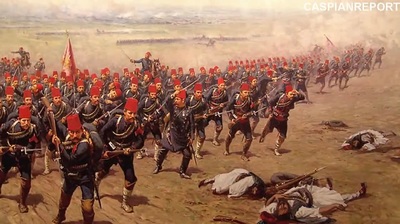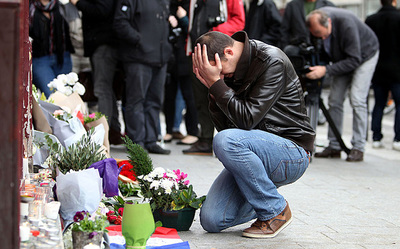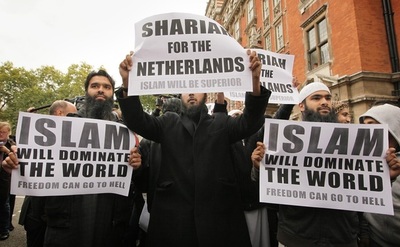|
Quite a few people have been asking about the ‘why’ of the terror attacks in Paris. Many others are shocked and surprised at the outburst of such extreme violence. For many however these attacks are hardly a surprise as they represent the most recent instalment of a process that got started in the 1950s with roots going back many centuries. Let me try and weave the component parts together into a narrative that I hope explains the ‘why’.
Collapse of the Ottoman Empire – It starts with the dismemberment of the Ottoman Empire after the First World War where on the remnants of that empire a number of artificial states were created in the Arab-Muslim world. All of these states came to be ruled by repressive autocrats or families who were more or less aligned with the western powers that defeated the Ottomans. Autocratic Rule - These ruling elites largely survived through divide and conquer policies (think Sunni vs. Shi’ite groups in Iraq and Syria) or by closely aligning with the region’s dominant religion (think of the House of Saud as protector of the holy shrines in Mecca and Medina). Needless to say, these despots have used the most brutal and inhuman techniques at their disposal to consolidate their hold on power. Saddam Hussein in Iraq, the Assad clan in Syria, Muammar Gaddafi in Libya are some of the more recent examples here. Resource-based Economies - The abundance of oil (Gulf States, Iraq, Saudi Arabia, Libya) prevented any form of economic or social innovation, the western petro-dollars kept flowing, creating a wealthy uber-elite that had no incentive to change, innovate or otherwise promote change to seek the betterment of their underlings. On the contrary, diversifying the economy would open the door to a level of foreign influence that could destabilize a hold on power that was tenuous at best. Many scholars have argued that an Arab world that at one point was highly successful and progressive reverted to anti-modernist stagnation. Channeling Resentment - Resentment and anger of the ordinary underlings could easily be channeled by directing tension and aggression to externalities. Israel was the regional bad guy to fight against, or the ‘other Muslim’ with the Iran-Iraq war that constituted the absolute violent low point in terms of intra-Muslim bloodshed last century. While this war of neighbours consolidated the ayatollah’s power in Iran and Saddam’s in Iraq, it created utter devastation for their citizens. Conflict with Modern and Secular World - Traditional Muslim life was challenged by modernity over the second half of the 20th century and as calls for progress through democracy were violently suppressed, a return to fundamental Islam (or Islamism) became a far more potent vehicle to challenge the westernized corrupt elites that governed the Arab world. Many have pointed to the Egyptian author and scholar Sayyid Qutb who emerged in the 1950s as a proponent of a return to tradional Islamist societies as a response to corrupt, westernized autocratic rule. Qutb is seen as the foundational ideologue of al-Qaeda and now, ISIS. Quest for Purity - As with most fundamentalist or totalitarian groups, the all-encompassing idea is to create a better world where the prevailing ideology provides a route to a pure and uniform society. In the case of Islam that meant a return to a form of government where the secular state and religious authority are merged into one and where Islamic doctrine governs day-to-day life. The best example of such an entity was the original caliphate of the 7th and 8th centuries. It also provided the antidote to the western model that separates church and state. Religion - And as opposed to fascism and communism where Hitler and Stalin banned or otherwise submerged religion, the religious doctrine in the fundamentalist mindset is the same as the political worldview to govern. When Hitler died fascism collapsed the next day, not so with Islam or Christianity for that matter as religion is far more potent than any secular worldview. It is outside the scope of my notes here, but the concept of God and the afterlife sets religion apart from any political ideology. Dissent and Religion Merge - So to go back to say the mid-1990s the dominant protest movement in the Middle East became radical Islam or Muslim fundamentalism, whatever term suits you best. The idea to resurrect the caliphate started to manifest itself violently and in pursuit of its goals severing the ties between the West and the Arab autocrats became one of its primary goals. It should be remembered that al-Qaeda under Osama bin Laden was able to emerge and grow in a fertile environment where first the Russians intervened in Afghanistan (1980s) and where the United States led a UN-sanctioned war against Saddam Hussein after he conquered Kuwait in the early 1990s. Attack the West, Provoke War, Weaken Local Rule - The 9/11 attacks completed the first phase of the process and the West’s response was exactly what al-Qaeda must have seen as its desired outcome: invasions in Afghanistan and Iraq, suppressing personal freedom in the West by creating a security state. All of these could potentially divide the West, weaken the local Arab autocrats and in time strengthen the hand of Islamists. The Quagmire – And that is pretty much what happened. The easy target was Saddam Hussein not only as a serial violator of UN resolutions, but Saddam himself had moved way too close to fundamentalism and organized terror in order to preserve his position which originally was far more pro-western and secular than the new make-up of the Arab world required him to be. So George Bush decided to remove him. Post-war Iraq was chaos and enabled local Iraqi fundamentalists under Abu Musab al-Zarqawi to create a foothold where western powers may have thought that a ‘fly-trap’ would get all radicals into Iraq where they could be defeated in a decisive manner. This did not happen and the United States beat a retreat, leaving a country in deep chaos under corrupt and sectarian Shi’ite rulers whose presence further strengthened the efforts of Sunni fundamentalists. Following Zarqawi’s death they re-emerged under the banner of ISIS. Arab Spring – All of this took place more or less around the same time of what came to be known as the Arab Spring of 2010-2012 where democratic uprisings (notably in Tunisia, Libya and Syria) saw a weakening of the old autocratic rule and a nascent democratic movement. But as we know now, opposition was not only channeled through believers in freedom and democracy, fundamentalists often gained the upper in hand in the revolts that emanated from that Arab spring. Noted examples are Libya, Syria and yes, Egypt, where a democratic experiment with a fundamentalist president (Mohamed Morsi) failed miserably. And there’s ISIS – So building on the groundwork of Qutb, al-Qaeda’s successes, the US failure in Iraq and its subsequent withdrawal, weakened Arab autocrats, combined with the emergence of newly energized fundamentalist groups provided the fertile soil for the creation of the Islamic State of Iraq and the Levant (ISIL) or now better known as ISIS. The Islamist Vanguard - As all revolutionary movements, be they fascist, communist, clerical or millennial in nature, a wealthier upper middle class vanguard establishes the way, think of the privileged upbringing Osama bin-Laden had or the background of Germany’s RAF terrorists. Or take Sayyid Qutb who studied in the United States, Colorado to be precise. They are the ones that conceptualize, create and finance the platform where the disgruntled troops can assemble and fight in pursuit of a better tomorrow, or in our case, a new caliphate governed by divine law. Alienated Converts - In the case of fundamentalist Islam, those initiators can draw on a large pool of potential converts, often than more than willing to take up arms and fight. They are essentially the unemployed or underutilized poor young men across the Middle East whose ranks have grown in a demographic boom that was never accompanied by an economic one. Add to this the very many Muslims across Europe (primarily Maghreb and Turkish influx to North and Western Europe) who are not only unemployed and underutilized, but alienated in a culture that is in all aspects diametrically opposed to the ones in which they grew up. Sexual Repression - And this brings us to the repressed sexuality in Muslim culture an element often overlooked but it stands to reason that it plays a crucial part in the emergence of fundamentalist violence. Traditional Muslim societies suppress both male and female sexuality and the resulting hormonal overdose for men can easily be channeled into violence. Let me give a simple example by pointing to that young and affluent Parisian couple where the girl is scantily dressed and both are enjoying a glass of wine in a trendy Paris bistro after a not so strenuous week at a local college or university. Their lives and values have been somewhat different, to say the least, from the single alienated Muslim youngster who empties his AK-47 on them. I hope this gets the point across. Europe - That brings us to Europe, at one point in the history parts of which were occupied by the Ottomans. The idea of the fundamentalists restoring their caliphate is fueled by the notion that its borders should once more extend to what they once were. Here the fundamentalist Muslim doctrine merges with nostalgic notions of a time past and of what could be tomorrow. Potent recruitment material. Is a European reconquest a real goal for ISIS? Hard to say, but in the current environment where the US has retreated, the north Atlantic alliance is at its weakest ever and where the Muslim segment of Europe’s population keeps growing in relative terms it is an attractive notion for ISIS to promote as part of its overall strategy of enlarging its domestic Arab footprint by severing the ties between Arab’s remaining autocratic rulers and European elites. Decadence and Freedom – And Europe (and America, Canada and Australia) represent the opposite of what fundamental Islam stands for: open and liberal gender relations, separation of church and state, increasing secularity (empty churches) and a general quest to enjoy life. We often see references from religious purists (not just Muslims, Christians too) to hedonism as one of the most abject expressions of life in Western societies. Any western city is now a perfect target and you do not have to necessarily bring in your recruits from overseas because they are already there. Paris has all of that and additionally a pretty terrible history with Muslims, few will recall the massacre of hundreds of Algerians in 1961 whose bodies were discarded in the Seine by the French police. More recently we can point to the cartoons published by Charlie Hebdo and the ensuing massacre at that magazine’s editorial offices. So what could be a more perfect target? It is outside the scope of this article to provide a solution to this deep and violent conflict. The core purpose is to explain in a short but hopefully enlightening way how we ended up in a world where a small group of terrorists can randomly butcher totally innocent people in a city far away from their ancestral homes. The most important thing to note is that there is no single and simple explanation like “if the United States had not invaded Iraq this would not have happened”. These are anti-intellectual short cuts that deserve no merit, as the reality is so much more complex. A number of things that I offer here may on their own not be solid evidence of contributing to terrorism, but together they constitute a narrative that may help us to understand the recent violence better. Anyone trying to find a solution will be perplexed by this complexity, which inevitably leads us to conclude that it will take a very long time before we can really address and solve it.
1 Comment
Simon W.
15/11/2015 09:13:01 am
Thought provoking
Reply
Leave a Reply. |
Archives
April 2020
Categories
All
|



 RSS Feed
RSS Feed